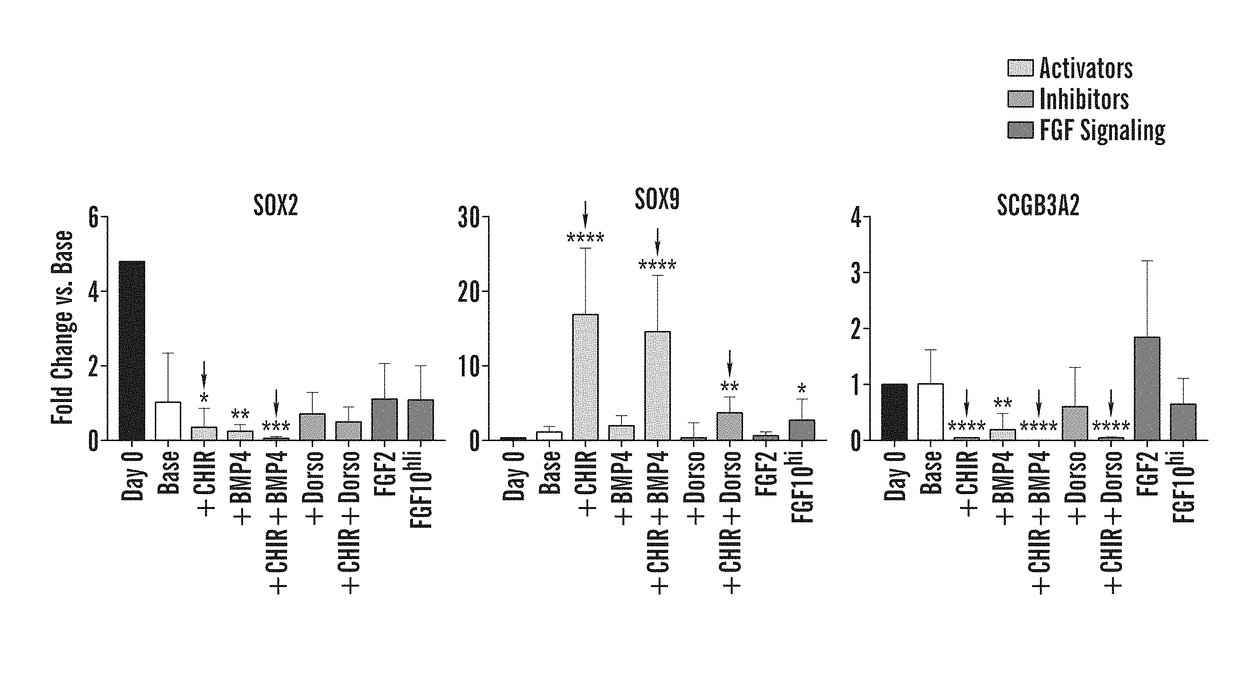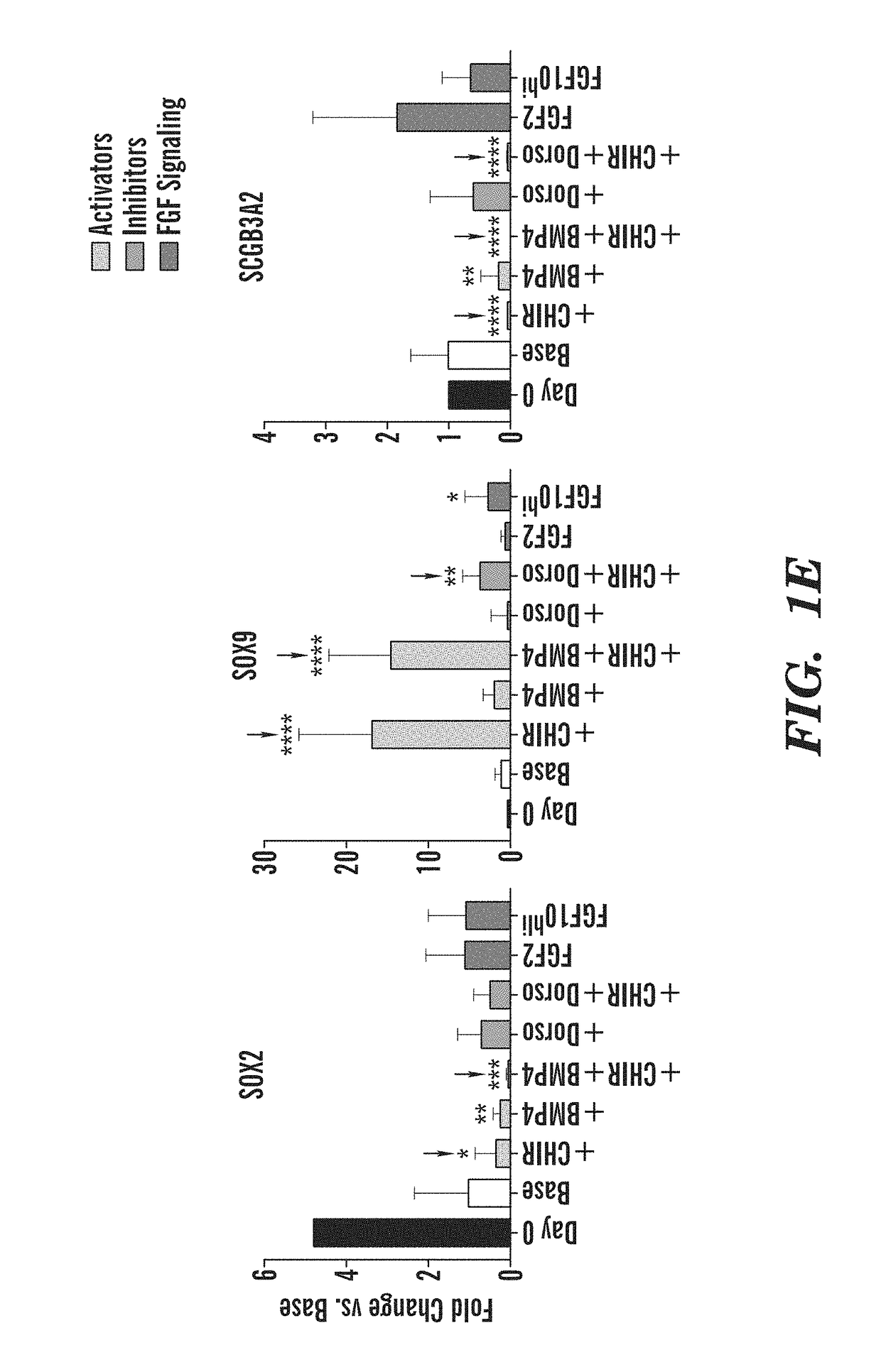Generation of airway epithelial organoids from human pluripotent stem cells
a technology of human pluripotent stem cells and airway epithelial cells, which is applied in the direction of peptides, drug compositions, peptide sources, etc., can solve problems such as challenging the achievement of this goal, and achieve the effect of increasing the activity and/or expression of gsk-3 and/or gsk3
- Summary
- Abstract
- Description
- Claims
- Application Information
AI Technical Summary
Benefits of technology
Problems solved by technology
Method used
Image
Examples
example 1
[0431]Screening Developmental Signaling Pathways Reveals Contribution from Wnt and BMP Signaling to Proximodistal Patterning of hPSC-Derived Lung Epithelium
[0432]To screen for potential mechanisms regulating human lung epithelial patterning after lung lineage specification, the inventors sought to employ an in vitro lung development model system that uses sequential medias in a stepwise, stage-specific approach to recapitulate the lineage specification of relatively undifferentiated (primordial) FOXA2+NKX2-1+ endodermal lung progenitors via anterior foregut endoderm from mouse or human pluripotent stem cells (PSCs) (FIG. 1A, FIG. 12A, 16A) (Huang et al., 2013; 2015; Longmire et al., 2012). Using this approach, the inventors derived NKX2-1+lung epithelial progenitors at varying efficiencies from several hPSC lines, including RUES2 (untargeted) and an iPSC line (hereafter C17) carrying a green fluorescent protein (GFP) reporter targeted to NKX2-1, the first gene locus activated in dev...
example 2
[0440]CHIR Withdrawal Post Lung Epithelial Specification Results in the Generation of Diverse Proximal Lung Lineages, Including NKX2-1+P63+ Basal-Like Cells
[0441]Next, the inventors assessed the effect of sustained vs. withdrawn Wnt signaling on the differentiation repertoire of hPSC-derived NKX2-1+ lung progenitors after lung lineage specification. The inventors treated cells post-specification with CHIR, recombinant mouse Wnt3a (Kishida et al., 1999), or neither in a base media of 10 ng / mL FGF10 from day 15 to day 19 (FIG. 2B, FIG. 9E). To ensure this treatment correlated with expected decreases in canonical Wnt signaling activity, the inventors confirmed reduced lentiviral TCF-driven reporter expression by day 19 (FIG. 9F) as well as reduced expression of the Wnt signaling responsive genes LEF1, NKD1, and AXIN2 (FIG. 2C). In addition, an unbiased comparison between NKX2-1GFP+ cells at day 15 and at day 19 after culture without CHIR using a Wnt pathway-specific qRT-PCR array confi...
example 3
[0444]CHIR Acts Intrinsically on the Epithelium to Pattern Early Lung Progenitors
[0445]Withdrawal of CHIR from day 15 to 19 resulted in a significantly decreased percentage of NKX2-1GFP+ outgrowth cells by day 19 (FIG. 10A-10B), raising the question of whether contaminating non-lung lineages were outcompeting lung lineages in the absence of sustained Wnt, and potentially contributing to secondary patterning effects in the NKX2-1+ population. The inventors next assessed whether the effect of CHIR manipulation on proximodistal lung patterning was intrinsic to lung epithelial cells rather than due to secondary or bystander effects. FACS was used to purify NKX2-1+GFP+ epithelial lung progenitors at day 14 and replated them in three-dimensional (3D) culture with or without CHIR (FIG. 3A) added to a base media (“DCI”) that has been previously reported to support epithelial gene expression in sorted NKX2-1GFP+ PSC-derived cells (Kurmann et al., 2015; Longmire et al., 2012). By day 20, the ...
PUM
| Property | Measurement | Unit |
|---|---|---|
| Current | aaaaa | aaaaa |
| Molar density | aaaaa | aaaaa |
| Molar density | aaaaa | aaaaa |
Abstract
Description
Claims
Application Information
 Login to View More
Login to View More - R&D
- Intellectual Property
- Life Sciences
- Materials
- Tech Scout
- Unparalleled Data Quality
- Higher Quality Content
- 60% Fewer Hallucinations
Browse by: Latest US Patents, China's latest patents, Technical Efficacy Thesaurus, Application Domain, Technology Topic, Popular Technical Reports.
© 2025 PatSnap. All rights reserved.Legal|Privacy policy|Modern Slavery Act Transparency Statement|Sitemap|About US| Contact US: help@patsnap.com



